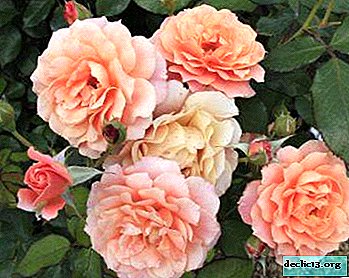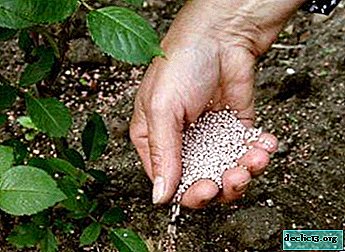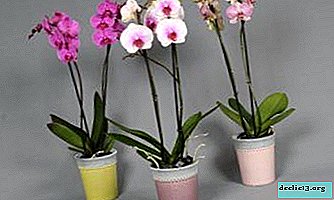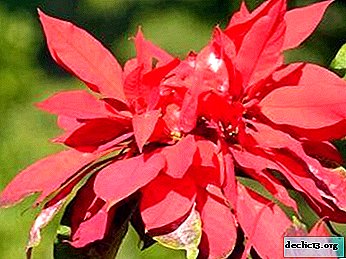Decoration of any garden - a rose "Watercolor" with an unusual color

Today it is difficult to imagine a flower garden or flower bed, in which the queen of flowers - a rose would not grow.
These popular shrubs like to grow many gardeners, and the abundance of their varieties can satisfy even the most sophisticated taste.
Quite often in the plots there is a variety of roses "Watercolor", which has its advantages and disadvantages. It is worthwhile to understand in more detail how to properly care for such a rose so that it always pleases the eye with abundant flowering.
Grade description
"Watercolor" is a tea-hybrid rose and it got its name due to the unusual color of the petals - their soft pink shades from the outside smoothly turn into milky or peach to the center.You can also recognize a flower by such signs:
- bush height - 70 - 120 cm;
- branches - erect, powerful, moderately sprawling with dark green glossy foliage;
- flowers - up to 12 cm in diameter;
- bushes in width - up to 50 cm;
- the shape of the buds is spherical with a core in the form of a cone;
- flower petals are thick, terry;
- golden brown stamens are visible inside the flower.
Watercolor roses flowers collected in inflorescences. On the stem, they can be located singly or up to 7 pieces at once.
The main advantages of this variety are cold resistance, constant flowering, resistance to powdery mildew and black spotting. Flowers practically do not fade in the sun and constantly delight the owners with their brightness. Gardeners consider the disadvantages that rather sprawling bushes take up a lot of space, bloom poorly with a lack of light, and also react painfully to drafts.
Photo
Below you can see a photo of the flower:





History of occurrence
The hybrid tea rose species was bred in 1999 in the German Tantau nursery by a breeder named Hans Jürgen Evers especially for cutting into bouquets. "Watercolor" is a descendant of the variety "Augusta Louise". It is also associated with such names by synonyms:
- TANellqua;
- Perfect harmony;
- St. Margaret's Gold.
It is worth noting that in 2010 at the rose competitions in Madrid and Rome, the variety won bronze medals.
Distinctive features
From many other types of roses, "Watercolor" is distinguished by smooth transitions of colors on the buds, and creamy yellow and reddish-orange shades favorably contrast against the background of brilliant green, dense foliage.Besides, the mass of the flower increases quite quickly, so in a short period of time it grows to large sizes. We also recognize this variety by its abundant flowering and delicate, stable aroma with pronounced citrus and fruity notes.
After cutting, the flowers can stand in the vase for at least 7 days.
It should be noted that bush is great for growing in closed rose gardens and crates.
Bloom
 Rose "Watercolor" is famous for its abundant flowering throughout the growing season.
Rose "Watercolor" is famous for its abundant flowering throughout the growing season.
The buds appear one at a time or with tassels on sturdy and long shoots, and in the flower there can be up to 70 densely arranged petals. Flowering begins approximately in June and ends in late autumn.
In order for the buds to appear throughout the season, you need to not only fertilize in a timely manner, provide watering, loosen the soil, but also correctly trim the bushes. "Watercolor" needs a basic haircut in the spring and additional during the summer.
It consists in the removal of damaged branches, sprouts and buds from the bush, which have faded and prevent further formation. In autumn (late October) unripe buds, shoots and leaves are cut.
New buds of this variety appear on young shoots, so it is not recommended to remove them. The ovaries of fruits that appear after flowering are also cut off, since they take away the vital force from the plant.
In warmer regions, only corrective spring pruning is allowed.and in cold, with unstable weather conditions - autumn-winter haircut will become a prevention of freezing.
Novice gardeners often face the problem of lack of flowering. In this case, it is important to identify the causes in a timely manner and take appropriate measures to address them.
| Causes | Necessary measures |
| little time has passed since the bush transplant | let the plant adapt and prepare for the next season |
| bad ground | loosen the soil to a depth of 70 cm, introduce nutrients and minerals into it |
| bad place | choose a bright, sunny area without drafts for a rose |
| insufficient moisture in the soil | carry out timely watering |
| the presence of diseases and pests | carry out preventive measures and pest / disease control |
Incorrect pruning and preparation for winter also negatively affect the flowering of Watercolors.. In the latter case, the bush will not freeze, but it will only release green leaves, and the buds will not appear on it.
Use in landscape design
The combination of bright aroma and rapid flowering allows you to use the rose variety in various garden compositions for any purpose (on high boles, curbs, mixborders, against stone retaining walls).
"Watercolor" looks great in a flowerbed, if planted in small groups. It looks great next to coniferous and ornamental deciduous plants. According to the color scheme, the rose harmonizes with the colors of the same color. They can be pink, yellow, apricot, red, white, purple or blue.
As neighbors for the rose, experts select curly, long-flowering plants - honeysuckle, sweet peas, clematis, kobe, kampsis, wisteria, morning glory or other types of roses.Care instructions
Landing
 It is recommended to plant the considered variety of roses in a bright area or in partial shade - sunlight should fall on the plant for at least 3-4 hours a day, otherwise it will develop poorly. It should be noted that the midday sun leaves burns on rose petals.
It is recommended to plant the considered variety of roses in a bright area or in partial shade - sunlight should fall on the plant for at least 3-4 hours a day, otherwise it will develop poorly. It should be noted that the midday sun leaves burns on rose petals.
Flat areas will not allow moisture to stagnate and prevent root decay.
Hybrid tea species prefer neutral, slightly acidic soils, rich in nutrients and with good drainage. To grow the Watercolor rose from seeds, you must not forget that the plant is extremely whimsical, therefore, to obtain strong seedlings, it is important to follow such a germination technology:
- use material from overripe fruits collected approximately in August;
- cut the box with a sharp knife, put its contents on the bottom of the sieve and immerse it in a container with hydrogen peroxide;
- place seeds after 2-3 hours between cotton swabs soaked in peroxide;
- put the resulting pads in plastic, hermetically sealed bags.
The first sprouts will appear in 2-3 weeks - they are planted in peat tablets for further rooting. Growing seedlings are watered as the substrate dries.. Seedlings are grown from seeds at a temperature of 18-20 degrees, and the light regime should be at least 10 hours a day.
To form a powerful root system that allows seedlings to better take root in the open ground, you need to carefully pick off the first buds that appear.
Watering
Watering "Watercolors" is carried out as necessary - under the base of the bush (2-3 times a week), 10 liters of settled warm water are poured in small portions. In the dry period, this is done more often and alternates with spraying.
Significantly reduces the number of weeds and prevents the evaporation of moisture from introducing mulch around the bush.Top dressing
Rosa needs regular top dressing, which prolongs the flowering period and makes the plant more resistant to cold, disease, pests. In the first year after planting, if the planting pit was well tucked, roses do not need mineral fertilizers. In the future, dressings are made according to the following scheme:
 in early spring, ammonium nitrate (30 g per square meter) is scattered 10-15 cm from the root neck, followed by embedment in the ground;
in early spring, ammonium nitrate (30 g per square meter) is scattered 10-15 cm from the root neck, followed by embedment in the ground;- during the period of growth and development of buds, use nitrogen and potassium products every 2 weeks;
- in summer, combine organic fertilizers with mineral;
- before the onset of winter cold fertilize phosphorus-potassium complexes.
Alternatively, it is permissible to use mulch-dressing from a mixture of soil and manure (2: 1) - the substance is introduced at each watering.
Pruning
For the first time, roses are pruned in the spring - immediately after planting in the ground. This year, shoots are cut for 3 buds, and in subsequent ones for 6-7. The slice is then made oblique, at a distance of 5 mm from the kidney. In spring, tea, hybrid roses remove old, diseased overwintered shoots and form a bush. In summer, sanitary pruning is carried out - until mid-July a wilted bud is cut along with the stem (3-4 leaves are left above the ground), and then only the flower is cut.
Transfer
It is best to transplant roses in April-May, when the weather is warm and the soil warms up. The procedure can be carried out in June - before the onset of heat. A sapling is dug up with the largest possible lump of earth and transferred to a hole filled with a soil mixture, in equal parts consisting of:
- sand with organic matter (humus, cow dung or peat);
- soil.
Preparation for winter
Since "Watercolor" is a moderately frost-resistant variety that can withstand temperatures of -9 degrees without shelter, experts advise to insulate the bushes, having previously cut the shoots to 10 cm and sprinkled sections for ash disinfection.
Then the plant grows up, and the remaining branches are covered with spruce branches or dry foliage. You can also cover the rose with a box and wrap it on top with agrofibre. With this method, it is necessary to ensure air circulation, leaving a small space.
It is strictly forbidden to use straw, sawdust, hay, moss or dung when preparing bushes for wintering, as these materials lead to dampness, decay and further death of the rose.
How to propagate?
 Often the propagation of tea-hybrid rose varieties is carried out by cuttings:
Often the propagation of tea-hybrid rose varieties is carried out by cuttings:
- In mid-August, a half-woody shoot is taken as material.
- He cuts out the middle of a length of 7-10 cm with the presence of 3 kidneys. The cut is cut so that the lower cut is straight and the upper cut is oblique. Its bottom is located under the lower kidney, and the top is 0.5-1 cm higher than the kidney.
- The bottommost sheet is completely removed, and the rest are cut in half or a third.
- Before planting, the material is soaked in a Kornevin solution, and then planted at a slope of 45 degrees on a bed with fertile soil.
- The cuttings are constantly kept moist by spraying and watering.
- To prevent evaporation of moisture, planting material is covered with plastic wrap or glass containers.
- The stalk will turn into a seedling after 2 years. In this case, one must not forget to warm it before the onset of winter.
Diseases and Pests
"Watercolor" is resistant to the appearance of powdery mildew, but it is still exposed to such diseases and pests:
- caterpillars
- aphid;
- leaflets;
- spider mites;
- nematodes;
- gray rot;
- rust.
At first glance, it seems that the hybrid tea requires some attention and care, but with proper care it will certainly please everyone with its flowering and aroma.

 in early spring, ammonium nitrate (30 g per square meter) is scattered 10-15 cm from the root neck, followed by embedment in the ground;
in early spring, ammonium nitrate (30 g per square meter) is scattered 10-15 cm from the root neck, followed by embedment in the ground;















